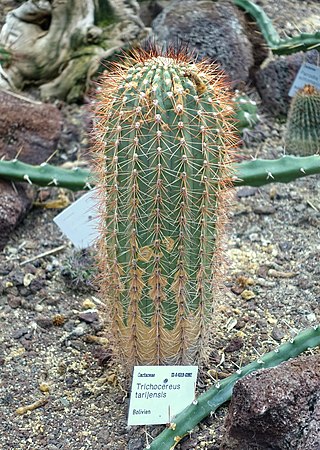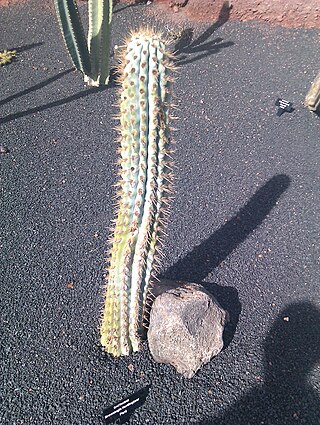
Matucana aurantiaca is a species of flowering plant in the cactus family Cactaceae. It grows in the Cajamarca and La Libertad regions of Peru. It is considered to have a stable population and a wide range with no threats.

Weberbauerocereus weberbaueri is a species of Weberbauerocereus from Peru.

Echinopsis tacaquirensis, is a species of Echinopsis found in Bolivia.

Soehrensia tarijensis, is a species of Soehrensia, in the cactus family. It is native to Bolivia and northwestern Argentina.

Lobivia schieliana, is a species of Lobivia found in Bolivia and Peru.

Lobivia pampana is a species of Lobivia found in Peru.

Lobivia maximiliana, is a species of Lobivia found in Bolivia and Peru.

Melocactus ernesti is one of the Turk's cap cacti, and is native to Bahia and Minas Gerais States, Brazil.

Haageocereus decumbens is a species of Haageocereus found in S. Peru to Chile (Tarapacá)

Haageocereus pseudomelanostele is a species of Haageocereus found in Peru

Armatocereus procerus is a species of Armatocereus found in southern Peru.

Cleistocactus candelilla is a species of Cleistocactus found in Bolivia.

Browningia hertlingiana is a species of Browningia found in Peru.

Matucana formosa is a species of Matucana found in Peru.

Matucana weberbaueri is a species of Matucana found in Peru.

Matucana madisoniorum is a species of Matucana found in Peru.

Matucana krahnii is a species of Matucana found in Peru.

Haageocereus acranthus is a species of Haageocereus found in Peru.

Loxanthocereus xylorhizus is a species of Loxanthocereus found in Peru.

Oreocereus leucotrichus is a species of cactus native to Peru and Chile.























